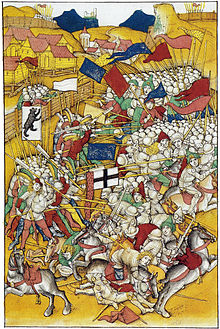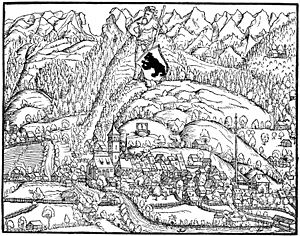Appenzell Wars
| date | 1401 to 1429 |
|---|---|
| place | Eastern Switzerland , Vorarlberg , Southern Germany |
| output | |
| consequences | The state of Appenzell becomes independent |
| Peace treaty | Peace of Constance on July 26th 1429 |
| Parties to the conflict | |
|---|---|
|
|
|
| Commander | |
|
Duke Friedrich IV of Habsburg |
|
Vögelinsegg - Rotmonten - Stoss - Bregenz - Herisau
The Appenzell Wars were a series of armed conflicts between the Prince Abbot of St. Gallen and the communities of the Appenzellerland in the first third of the 15th century.
prehistory
The state of Appenzell has been under the Prince Abbey of St. Gallen since the early Middle Ages . The land was administered decentrally by the abbey through so-called offices, each of which was headed by an Ammann, an Appenzell farmer appointed by the abbot. These offices acted as the nucleus for local autonomy efforts of the peasants. When the prince abbot was able to acquire the imperial bailiwick over Appenzell in 1345 , the country threatened to be included in the territorial rule of the prince abbey.
Abbots Georg von Wildenstein (1360–1379) and Kuno von Stoffeln (1379–1411) tried to reclaim taxes from the Appenzell people that were legally justified but not used. This aroused resistance in the state of Appenzell, but also in the city of St. Gallen, which on January 17, 1401 resulted in an alliance between the city of St. Gallen and the five Appenzell municipalities of Appenzell , Gais , Hundwil , Teufen and Urnäsch . The conflict between the two parties mainly revolved around the rights to freedom of movement, marriage, inheritance and alienation of fiefs of the abbey as well as hunting and fishing rights.
course
Beginning of the war
The conflict escalated into armed conflict when the allies destroyed the Clanx Castle near Appenzell, which belonged to the abbey . The Swabian cities on Lake Constance , called by the abbot as arbitrators, ruled against the Appenzeller in 1402 and declared their association to be illegal. St. Gallen submitted to the arbitration award and prematurely withdrew from its alliance with the Appenzell people. However, they did not want to submit to the ruling and turned to the Swiss town of Schwyz for help . This included the Appenzeller in his land law at the beginning of 1403 and led them politically and militarily from then on. This was the first step towards Appenzell's later entry into the federal government . The feud against the prince abbey was intensified under Swiss leadership . There was robbery and looting on their territory, so that the abbot, who had initially tried to defuse the dispute through negotiations, prepared for war.
Appenzell victory and Habsburg intervention

On May 15, 1403 the so-called Battle of Vögelinsegg took place , in which the Appenzell people fled the abbot's army - although it was reinforced by troops from Constance - and pursued it to the gates of the city of St. Gallen. The abbot's losses amounted to around 300 men, 99 of them from Constance alone. Only eight men from Appenzell are said to have died.
The abbot's alliance fell apart after the defeat, but he found in the Habsburg Leopold IV , Duke of Austria and Count of Tyrol, a new ally against the rebellious Appenzell farmers. With this the duke hoped to secure the connection between his Vorarlberg-Tyrolean possessions and the Habsburg Thurgau . He transferred the leadership of the campaign to his younger brother Friedrich IV. Since the federal places had concluded a twenty-year peace with the House of Habsburg in 1394, the abbot achieved the withdrawal of the Schwyz from the alliance with Appenzell with this move. The Appenzeller remained in Schwyz land law . The eight old towns rejected a request by the Habsburgs to join the fight on their side, as they recognized that they were looking for an increase in power in what is now eastern Switzerland , which could have been dangerous for them. In return, the city of St. Gallen took the side of the Appenzeller, as it feared that the abbot would gain too much power.
On the morning of June 17, 1405, the Battle of the Stoss broke out between Altstätten and Gais , in which the Appenzell people fought back a Habsburg army that had tried to advance from the Rhine valley into the Appenzell region.
The federal government over the lake and the first peace treaty
At the instigation of the people of Schwyz, the people of Appenzell then founded the federation above the lake against the «prince violence» and pushed their way into the neighboring regions with impetuous raids. In the south they moved over the Toggenburg into the Linth Plain , in the west to the Thurgau and in the east under Ital Reding to Vorarlberg and Tyrol . For two years the Appenzell horrors spread among the princes and enthusiasm and hopes for freedom among peasants and peasants. So the Oberinntal farmers also joined them. On January 13, 1408, however, they suffered a defeat at Bregenz against an army of the Swabian Knight League Sankt Jörgenschild and the bishops of Augsburg and Constance , which cost them the reputation of invincibility. The Appenzeller withdrew to their home country, the Bund above the lake collapsed and was dissolved by the German King Ruprecht in the Konstanz arbitration award of April 4, 1408. He also confirmed the demands of the Abbot of St. Gallen against the Appenzeller. In 1410 a peace agreement was finally concluded. It was not until 1412 that the Tyrolean Oberlanders again made an oath of loyalty to the keeper of Laudegg and the sovereign on the Dingstrasse from Prutz .
Fighting flared up again
Appenzell still refused to pay the taxes owed to the abbot of St. Gallen. On November 24, 1411, the Appenzeller concluded an open-ended contract with the federal places - with the exception of Bern - to strengthen their position and placed themselves under their patronage. An arbitration ruling by the Confederates between Appenzell and the Abbey of St. Gallen in 1421 reduced the abbey's rights to the levies required from land and corporal rights to an annual levy of 100 pounds of silver, the treasure trove and a reduced imperial tax. The lower jurisdiction , however, was assigned to the Appenzell people. However, this added to the award is not so that after prior imposition of imperial ban in 1426 Abbot Heinrich von Mansfeld ban and interdict pronounced as extreme sanction measure over Appenzell. The Reichstag of Frankfurt therefore called on November 22nd, 1427 the Swabian League of Cities and the South German nobility to take up the fight against the Appenzeller in the name of the church and the empire. As a result, Count Friedrich VII of Toggenburg , supported by the Knights' Association of St. Jörgenschild, marched against Appenzell in 1428 and was victorious on December 2, 1428 in the battle at the Letzi near Hueb near Herisau.
Peace treaty
Appenzell now submitted to federal arbitration awards and recognized the duty to pay taxes to the St. Gallen monastery, so that on July 26, 1429 peace was finally established in Constance. This meant that some of the taxes had to be paid again, but Appenzell had asserted itself as an independent state against the abbey and was allowed to maintain its alliance with the confederates. Appenzell also had to pay the monastery compensation of 1000 pounds pfennigs.
literature
- Rhyming chronicle of the Appenzell War (1400–1404). Edited by Traugott Schiess. In: Communications on patriotic history, 35, 1919.
- Walter Ehrenzeller: St. Gallic History in the Late Middle Ages and the Reformation. Vol. 1. St. Gallen 1931, pp. 103-212.
- Peter Niederhäuser, Alois Niederstätter (eds.): The Appenzell Wars - a time of crisis on Lake Constance? Konstanz 2006 (= research on the history of Vorarlberg, NF 7).
Web links
- Karl Heinz Burmeister : Appenzell Wars. In: Historical Lexicon of Switzerland .
- Karl Heinz Burmeister: Appenzell War. In: Historical Lexicon of the Principality of Liechtenstein .
